#Sengoku japan
Explore tagged Tumblr posts
Note
Can you draw Japan in late Sengoku Era samurai armor?
this ask has been rotting in my inbox for like actual years and i still took a lot of liberties with it, drawing nyo japan as an onnamusha (female samurai) and archer instead LOL

faceful_of_arrow.jpg
#im not actually sure whether or not this is late sengoku era armor i was kinda freeballing#hetalia#nyo japan#hws nyo japan#aph nyo japan#ask#anonymous#historically inaccurate hair is historically inaccurate
478 notes
·
View notes
Text

or whatever kikyo said. that’s some real talk though.
#kikyo#inuyasha#inuyasha fandom#inukik#i love ghetto captions on anime#it makes me giggle#so i made this#inuyasha 1x15#anime#weeb#black girl#inuyasha head canon#kikyo x inuyasha#kagome#sesshomaru#sango#miroku#shippo inuyasha#naraku#feudal era#feudal japan#sengoku era#miko#shrine priestess#sacred arrow#shikon jewel#this is just for fun#comedy#black reader#rumiko takahashi
229 notes
·
View notes
Text
Shōgun Historical Shallow-Dive: the Final Part - The Samurai Were Assholes, When 'Accuracy' Isn't Accurate, Beautiful Art, and Where to From Here
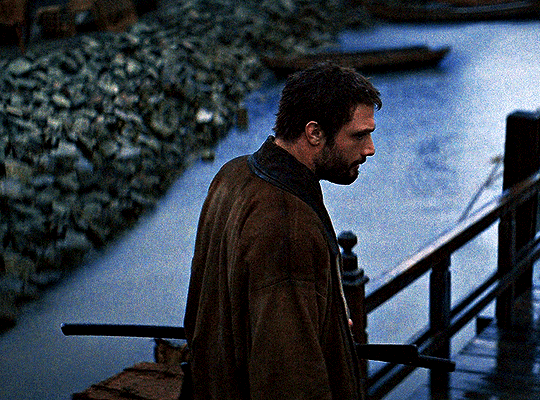
Final part. There is an enormous cancer attached to the samurai mythos and James Clavell's orientalism that I need to address. Well, I want to, anyway. In acknowledging how great the 2024 adaptation of Shōgun is, it's important to engage with the fact that it's fiction, and that much of its marketed authenticity is fake. That doesn't take away from it being an excellent work of fiction, but it is a very important distinction to me.
If you want to engage with the cool 'honourable men with swords' trope without thinking any deeper, navigate away now. Beyond here, there are monsters - literal and figurative. If you're interested in how different forms of media are used to manufacture consent and shape national identity, please bear with me.
I think the makers of 2024's Shōgun have done a fantastic job. But there is one underlying problem they never fully wrestled with. It's one that Hiroyuki Sanada, the leading man and face of the production team, is enthusiastically supportive of. And with the recent announcement of Season 2, it's likely to return. You may disagree, but to me, ignoring this dishonours the millions of people who were killed or brutalised by either the samurai class, or people in the 20th century inspired by a constructed idea of them.
Why are we drawn to the samurai?
A pretty badly sourced, but wildly popular history podcast contends that 'The Japanese are just like everybody else, only more so.' I saw a post on here that tried to make the assertion that the show's John Blackthorne would have been exposed to as much violence as he saw in Japan, and wouldn't have found it abnormal.
This is incorrect. Obviously 16th and 17th century Europe were violent places, but they contained violence familiar to Europeans through their cultural lens. Why am I confidently asserting this? We have hundreds of letters, journals and reports from Spaniards, Portuguese, Dutch and English expressing absolute horror about what they encountered. Testing swords on peasants was becoming so common that it would eventually become the law of the land. Crucifixion was enacted as a punishment for Christians - first by the Taiko, then by the Tokugawa shogunate - for irony's sake.
Before the end of the feudal period, battles would end with the taking of heads for washing and display. Depending on who was viewing them, this was either to honour them, or to gloat: 'I'm alive, you're dead.' These things were ritualised to the point of being codified when real-life Toranaga took control. Seppuku started as a cultural meme and ended up being the enforced punishment for any minor mistake for the 260 years the ruling samurai class acted as the nation's bureaucracy. It got more and more ritualised and flowery the more it got divorced from its origin: men being ordered by other men to kill themselves during a period of chaotic warfare. I've read accounts of samurai 'warriors' during the Edo period committing seppuku for being late for work. Not life-and-death warrior work - after Sekigahara, they were just book-keepers. They had desk jobs.
Since Europe's contact with Japan, the samurai myth has fascinated and appalled in equal measure. As time has gone on, the fascination has gone up and the horror has been dialled down. This is not an accident. This isn't just a change in the rest of the world's perception of the samurai. This is the result of approximately 120 years of Japanese government policies. Successive governments - nationalist, military authoritarian, and post-war democratic - began to lionize the samurai as the perfect warrior ideal, and sanitize the history of their origin and their heydey (the period Shōgun covers). It erases the fact that almost all of the fighting of the glorious samurai Sengoku Jidai was done by peasant ashigaru (levies), who had no choice.
It is important to never forget why this was done initially: to form an imagined-historical ideal of a fighting culture. An imagined fighting culture that Japanese invasion forces could emulate to take colonies and subdue foreign populations in WWI, and, much more brutally, in WWII. James Clavell came into contact with it as a Japanese Prisoner of War.
He just didn't have access to the long view, or he didn't care.
The Original Novel - How One Ayn Rand Fan Introduced Japan to America
There's a reason why 1975's Shogun novel contains so many historical anachronisms. James Clavell bought into a bunch of state-sanctioned lies, unachored in history, about the warring states period, the concept of bushido (manufactured after the samurai had stopped fighting), and the samurai class's role in Japanese history.
For the novel, I could go into great depth, but there are three things that stand out.
Never let the truth get in the way of a good story. He's a novelist, and he did what he liked. But Clavell's novel was groundbreaking in the 70's because it was sold as a lightly-fictionalised history of Japan. The unfortunate fact is the official version that was being taught at the time (and now) is horseshit, and used for far-right wing authoritarian/nationalist political projects. The Three Unifiers and the 'honour of the samurai' magnates at the time is a neat package to tell kids and adults, but it was manufactured by an early-20th century Japanese Imperial Government trying to harness nationalism for building up a war-ready population. Any slightly critical reading of the primary sources shows the samurai to be just like any ruling class - brutal, venal, self-interested, and horrifically cruel. Even to their contemporary warrior elites in Korea and China.
Fake history as propraganda. Clavell swallowed and regurgitated the 'death before dishonour', 'loyalty to the cause above all else', 'it's all for the Realm' messages that were deployed to justify Imperial Japanese Army Class-A war crimes during the war in the Pacific and the Creation of the Greater East Asian Co-Properity Sphere. This retroactive samurai ethos was used in the late Meiji restoration and early 20th century nationalist-military governments to radicalise young Japanese men into being willing to die for nothing, and kill without restraint. The best book on this is An Introduction to Japanese Society by Sugimoto Yoshio, but there is a vast corpus of scholarship to back it up.
Clavell's orientalism strays into outright racism. Despite the novel Shōgun undercutting John Blackthorne as a white savior in its final pages - showing him as just a pawn in the game - Clavell's politics come into play in every Asia Saga novel. A white man dominates an Asian culture through the power of capitalism. This is orthagonal to points 1 and 2, but Clavell was a devotee of Ayn Rand. There's a reason his protagonists all appear cut from the same cloth. They thrust their way into an unfamiliar society, they use their knowledge of trade and mercantilism to heroically save the day, they are remarked upon by the Asian characters as braver and stronger, and they are irresistible to the - mostly simpering, extremely submissive - caricatures of Asian women in his novels. Call it a product of its times or a product of Clavell's beliefs, I still find it repulsive. Clavell invents (nearly from whole cloth, actually) the idea that samurai find money repulsive and distasteful, and his Blackthorne shows them the power of commerce and markets. Plus there are numerous other stereotypes (Blackthorne's massive dick! Japanese men have tiny penises! Everyone gets naked and bathes together because they're so sexually free! White guys are automatically cool over there!) that have fuelled the fantasies of generations of non-Japanese men, usually white: Clavell's primary audience of 'dad history' buffs.
2024's Shōgun, as a television adaptation, did a far better job in almost every respect
But the show did much better, right? Yes. Unquestionably. It was an incredible achievement in bringing forward a tired, stereotypical story to add new themes of cultural encounter, questioning one's place in the broader world, and killing your ego. In many ways, the show was the antithesis to Clavell's thesis.
It drastically reigned in the anachronistic, ahistorical referencees to 'bushido' and 'samurai honor', and showed the ruling class of Japan in 1600 much more accurately. John Blackthorne (William Adams) was shown to be an extraordinary person, but he wasn't central to the outcome of the Eastern Army-Western Army civil war. There aren't scenes of him being the best lover every woman he encounters in Japan has ever had (if you haven't read the book, this is not an exaggeration). He doesn't teach Japanese warriors how to use matchlock rifles, which they had been doing for two hundred years. He doesn't change the outcome of enormous events with his thrusting, self-confident individualism. In 2024's Shōgun, Blackthorne is much like his historical counterpart. He was there for fascinating events, but not central. He wasn't teaching Japanese people basic concepts like how to make money or how to make war.
On fake history - the manufactured samurai mythos - it improved on the novel, but didn't overcome the central problems. In many ways, I can't blame the showrunners. Many of the central lies (and they are deliberate lies) constructed around the concept of samurai are hallmarks of the genre. But it's still important to me to notice when it's happening - even while enjoying some of the tropes - without passively accepting it.
'Authenticity' to a precisely manufactured story, not to history
There's a core problem surrounding the promotion and manufactured discussion surrounding 2024's Shōgun. I think it's a disconnect between the creative and marketing teams, but it came up again and again in advertising and promotion for the show: 'It's authentic. It's as real as possible.'
I've only seen this brought up in one article, Shōgun Has a Japanese-Superiority Complex, by Ryu Spaeth:
'The show also valorizes a supreme military power that is tempered by the pursuit of beauty and the highest of cultures, as if that might be a formula for peace. Shōgun displays these two extremes of the Japanese self, the savagery and the refinement, but seems wholly unaware that there may be a connection between them, that the exquisite sensibility Japan is famous for may flow from, and be a mask for, its many uses of atrocious domination.'
Here we come to authenticity.
'The publicity surrounding the series has focused on its fidelity to authenticity: multiple rounds of translation to give the dialogue a “classical” feel; fastidious attention to how katana swords should be slung, how women of the nobility should fold their knees when they sit, how kimonos should be colored and styled; and, crucially, a decentralization of the narrative so that it’s not dominated by the character John Blackthorne.'
It's undeniable that the 2024 production spent enormous amounts of energy on authenticity. But authenticity to what? To traditional depictions of samurai in Japanese media, not to history itself. The experts hired for gestures, movement, costumes, buildings, and every other aspect of the show were experts with decades in experience making Japanese historical dramas 'look right', not experts in Japanese history. But this appeal to 'Japanese authenticity' was made in almost every piece of promotional material.
The show had only one historical advisor on staff, and he was Dutch. The numerous Japanese consultants, experts and specialists brought on board (talked about at length in the show's marketing and behind the scenes) were there to assist with making an accurate Japanese jidaigeki. It's the difference between hiring an experienced BBC period drama consultant, and a historian specialising in the Regency. One knows how to make things look 'right' to a British audience. The other knows what actually happened.
That's fine, but a critical viewing of the show needs to engage with this. It's a stylistically accurate Japanese period drama. It is not an accurate telling of Japanese history around the unification of Japan. If it was, the horses would be the size of ponies, there would be far more malnourished and brutalised peasants, the word samurai would have far less importance as it wasn't yet a rigidly enforced caste, seppuku wouldn't yet be ritualised and performed with as much frequency, and Toranaga - Tokugawa - would be a famously corpulently obese man, pounding the saddle of his horse in frustration at minor setbacks, as he was in history.
The noble picture of restraint, patience, refinement and honour presented by Hiroyuki Sanada as Toranaga/Tokugawa is historical sanitation at its most extreme. Despite being Sanada's personal hero, Tokugawa Ieyasu was a brutal warlord (even for the standards of the time), and he committed acts of horrific cruelty. He ordered many more after gaining ultimate power. Think a miniseries about the Founding Fathers of the United States that doesn't touch upon slavery - I'm sure there have been plenty.
The final myth that 2024's Shōgun leaves us with is that it took a man like Toranaga - Tokugawa Ieyasu - to bring peace to a land ripped assunder by chaos. This plays into 19th century notions of Great Man History, and is a neat story, but the consensus amongst historians is if it wasn't Tokugawa, it would have been some other cunt. In many cases, it very nearly was. His success was historical contingency, not 5D chess.
So how did this image get manufactured, to the point where the Japanese populace - by and large - believes it to be true? Very long story short: after a period of rapid modernisation, Japan embraced nationalism in the late 19th century. It was all the rage. Nationalism depends on a glorified past. The samurai (recently the pariahs of Japanese history) were repurposed as Japan's unique warrior heroes, and woven into state education. This was especially heated in the 1920s and 30s in the lead up to the invasion of Manchuria and Japan's war of aggression in the Pacific. Nationalism + militarism = the modern Japanese samurai myth, to prepare men to obey orders unquestioningly from a military dictatorship.
This persists in the postwar period. Every year since 1963, Japan's state broadcaster NHK commissions a historical drama - a Taiga Drama, where many of this show's actors got their starts - that manufactures and re-enforces the idea of samurai as noble, artful, honourable people. Read a book - read a Wikipedia article! - and you'll see that most of it stems from Tokugawa-shogunate era self-propaganda. It's much like the European re-interpretation of chivalry. In Europe's case, chivalry in actual history was a set of guidelines that allowed for the sanctioned mass-rape and murder of civilians, with a side of rules regarding the ransoming of nobles in scorched-earth military campaigns. In Japan's case, historical figures that regularly backstabbed each other, tortured rival warriors and their lessers, and inflicted horrific casualties on the peasants that they owned (we have a term for that) are cast as noble, honourable, dedicated servants of the Empire.
Why does this matter to me? Samurai movies and TV shows are just media, after all. The issue, for me, is that the actors, the producers - including Hiroyuki Sanada - passionately extoll 'accuracy' as if they genuinely believe they're telling history. They talk emotionally about bushido and its special place in Japanese society.
But the entire concept of bushido is a retroactive, post-conflict, samurai construction. Bushio is bullshit. Despite being spoken of as the central tenet of 2024's Shōgun by actors like Hiroyuki Sanada, Tadanobu Asano, and Tokuma Nishioka, it simply didn't exist at the time. It was made up after the advent of modern nationalism.
It was used to justify horrendous acts during the late Edo period, the Meiji restoration, and the years leading up to the conclusion of Japan's war of aggression in the Pacific. It's still used now by Japan's primarily right-wing government to deny war crimes and justify the horrors unleashed on Asia and the Pacific during World War II as some kind of noble warrior crusade. If you ever want your stomach turned, visit the museum attached to Yasukuni Shrine. It's a theme park dedicated to war crimes denial, linked intimately to Japan's imagined warrior past. Whether or not the production staff, cast, and marketing team of 2024's Shōgun knew they were engaging with a long line of ahistorical bullshit is unknown, but it is important.
It's also important to acknowledge that, having listened to many interviews with Rachel Kondo and Justin Marks, they were acutely aware that they weren't Japanese, to claim to be telling an authentically Japanese story would be wrong, and that all they could do was do their best to make an engaging work that plays on ideas of cultural encounter and letting go. I think the 'authenticity!' thing is mostly marketing, and judicious editing of what the creators and writers actually said in interviews.
So... you hate the show, then? What the hell is this all about?
No, I love the show. It's beautiful. But it's a beautiful artwork.

Just as the noh theatre in the show was a twisting of events within the show, so are all works of fiction that take inspiration from history. Some do it better than others. And on balance, in the show, Shōgun did it better than most. But so much of the marketing and the discussion of this adaptation has been on its accuracy. This has been by design - it was the strategy Disney adopted to market the show and give it a unique viewing proposition.
'This time, Shōgun is authentic!*
*an authentic Japanese period drama, but we won't mention that part.
And audiences have conflated that with what actually happened, as opposed to accuracy to a particular form of Japanese propaganda that has been honed over a century. This difference is crucial.
It doesn't detract from my enjoyment of it. Where I view James Clavell's novel as a horrid remnant of an orientalist, racist past, I believe the showrunners of 2024's Shōgun have updated that story to put Japanese characters front and centre, to decentralise the white protagonist to a more accurate place of observation and interest, and do their best to make a compelling subversion of the 'stranger in a strange land' tale.
But I don't want anyone who reads my words or has followed this series to think that the samurai were better than the armed thugs of any society. They weren't more noble, they weren't more honourable, they weren't more restrained. They just had 260 years in which they worked desk-jobs while wearing two swords to write stories about how glorious the good old days were, and how great people were.
Well... that's a bleak note to end on. Where to from here?
There are beautiful works of fiction that engage much closer with the actual truth of the samurai class that I'd recommend. One even stars Hiroyuki Sanada, and is (I think) his finest role.
I'd really encourage anyone who enjoyed Shōgun to check out The Twilight Samurai. That was the reality for the vast majority of post-Sekigahara samurai
For something closer to the period that Shogun is set, the best film is Seppuku (Hara-Kiri in English releases). It is a post-war Japanese film that engages both with the reality of samurai rule, and, through its central themes, how that created mythos was used to radicalise millions of Japanese into senseless death during the war. It is the best possible response to a romanticisation of a brutal, hateful period of history, dominated by cruel men who put power first, every single time.
I want to end this series, if I can, with hope. I hope that reading the novel or watching the 1980 show or the 2024 show has ignited in people an interest in Japanese culture, or society, or history. But don't let that be an end. Go further. There are so many things that aren't whitewashed warlords nobly killing - the social history of Japan is amazing, as is the women's history. A great book for getting an introduction to this is The Japanese: A History in 20 Lives.
And outside of that, there are so many beautiful Japanese movies and shows that don't deal with glorified violence and death. In fact, it makes up the vast majority of Japanese media! Who would have thought! Your Name was the first major work of art to bridge some of the cultural animosity between China and Japan stemming from WW2, and is a goofy time travel love story. Perfect Days is a beautiful movie about the simple joy of living, and it's about the most Tokyo story you can get.
Please go out, read more, watch more. If you can, try and find your way to Japan. It's one of the most beautiful places on earth. The people are kind, the food is delicious, and the culture is very welcoming to foreigners.
2024's Shōgun was great, but please don't let that be the end. Let it be the beginning, and I hope it serves as a gateway for you.
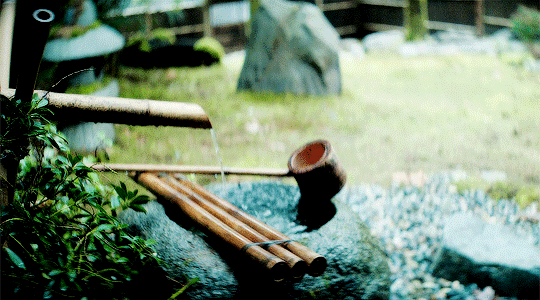
And I hope our little fandom on here remembers this show as a special time, where we came together to talk about something we loved. I'll miss you all.
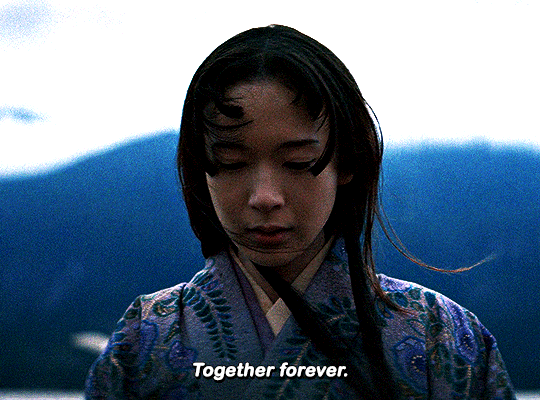
#shōgun#shogun#shogun fx#toda mariko#john blackthorne#anjin#adaptationsdaily#perioddramasource#hiroyuki sanada#yoshii toranaga#akechi mariko#history#history lesson#japan#world war ii#japanese culture#tokugawa ieyasu#hosokowa gracia#william adams#sengoku jidai#writer stuff#book adaptation#women in history#social history#period drama
153 notes
·
View notes
Text

hbd shinobu
#ensemble stars#enstars#my art#shinobu sengoku#its currently 12 am in japan! thought I could share this here#background is mostly based on a picture I had a while back
115 notes
·
View notes
Text
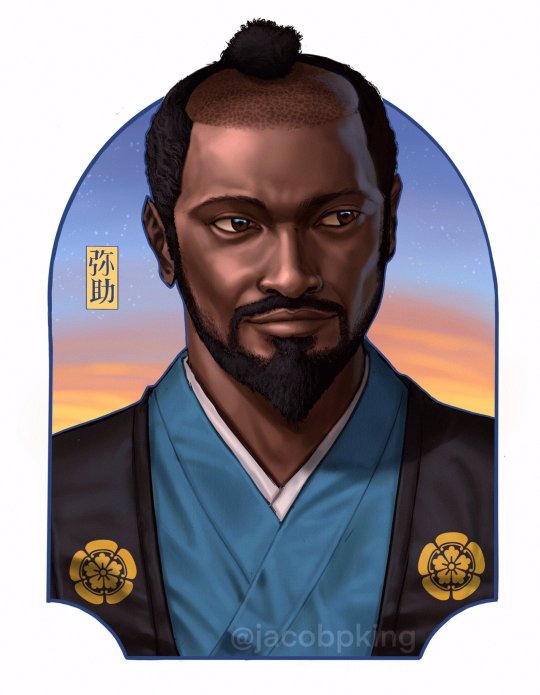
Yasuke - the African Samurai One of the most fascinating historical figures of all time imo; a former-slave (likely) from Mozambique who was sent to Japan by Portuguese Jesuits and became a retainer under Oda Nobunaga. What a story! I hope you guys enjoy
#art#illustration#artwork#digital art#samurai#ancient japan#sengoku jidai#warring states era#japan#yasuke#oda nobunaga#history tag#history#culture#soldier#warrior#historical#ancient history#16th century
116 notes
·
View notes
Text

Shogun : E4 | “The Eightfold Fence”
#shogun fx#fx shogun#samurai#japan#ronin#cinama#japanese culture#shogun#vagabond#sengoku jidai#anime#shōgun#shōgun fx
91 notes
·
View notes
Text
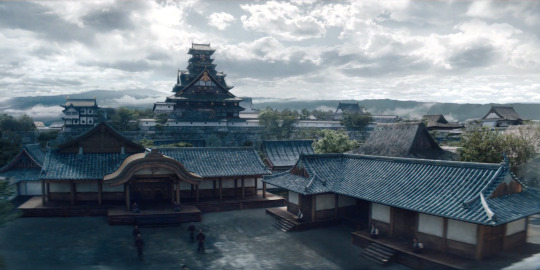

Fun Trivia : Did you know that Osaka Castle was black?
It was built by the real Taiko, Toyotomi Hideyoshi, before it was destroyed and reconstructed into a white castle by Tokugawa Ieyasu. After the death of the "dictator" Oda Nobunaga, Hideyoshi constructed impressive castles like Osaka to herald his new position.
Castles that were built during Hideyoshi's reign like Hiroshima, Okayama and Matsumoto are black. Castles built during Tokugawa's reign like Hikone, Himeji and Nagoya are white. So when you see a castle on your next trip to Japan, you can guess who built it. 😉
The differences in color is due to the resources availability at the time, as white plastering were more expensive than black lacquered timber, so it is of no surprise that Tokugawa later used white for his castles as a symbol of wealth and power.
You can read more from the book, Samurai Castles by Jennifer Mitchelhill which share the history of Japanese castles, from its designs, architectures, layouts, significance and legends, coupled with wonderful photos of the castles by David Green.
#osaka castle#japan#samurai castle#japanese castle#shogun#shogun fx#shogun 2024#toyotomi hideyoshi#tokugawa ieyasu#oda nobunaga#sengoku jidai#japanese culture#hiroshima castle#okayama castle#matsumoto castle#hikone castle#himeji castle#nagoya castle
74 notes
·
View notes
Text

The sunshine / the salty boi
Based on this
#tiger & bunny#tiger and bunny#subaru sengoku#thomas taurus#thomaru#lol idk i drew this in 2 hrs#theyre stupid#this is queued im in japan lol
27 notes
·
View notes
Link
“From the Onin War’s start in 1467, the Japanese islands were almost continuously at war for a full century. Kita came from two high-ranking samurai families in northern Japan, the Oniniwa and Katakura, who served local lord Date Terumune. At the time, the Date clan was but one among many in the region, with far more powerful, blue-blooded, influential and potentially dangerous ruling clans for neighbors. Like many warrior-caste daughters during this era of civil upheaval, Kita knew how to fight. What set her apart was a pronounced interest in and aptitude for the martial arts and military science. She was so skilled that she took it upon herself to act as a teacher to her half-brother Kagetsuna, who was heir to the Katakura headship.
The Date clan was slowly putting itself back together after infighting nearly destroyed it when, in 1567, a new heir, Bontenmaru, was born. Terumune ordered, Kita, then 29, to serve as wet nurse to the newborn. His birth mother, Yoshi, showed little interest in being maternal, and at certain times even tried to have him murdered to advance her own family’s political interests. Kita, by contrast, was especially close to Bontenmaru. Over the years, she nourished not only his body but also became one of his earliest teachers in both the literary and martial arts, helping shape him into a leader whose reputation in battle and politics earned him the moniker of One-Eyed Dragon.
With strong opinions and powerful support from men of privilege and influence, Kita advocated for the young heir’s succession to Date headship. And in 1584, despite Yoshi’s best attempts to prevent it, she got her wish. Bontenmaru transcended both battlefield injury and illness — including a small-pox outbreak that claimed his right eye — to become Date Masamune, the clever, stylish, internationalist warlord who took the Date clan from obscurity to fame as the fourth wealthiest family in Japan.”
#japan#history#women in history#women's history#samurai#japanese history#15th century#sengoku period#date masamune#warrior women#women warriors#historical figures#herstory#sengoku#samurai women#female samurai
65 notes
·
View notes
Text
One thing I love about ikesen is that without it I would have never heard what the sengoku period was. Im so glad I’ve come across this game and come to b aware of this time period.
(Currently learning bout (irl) hideyoshi’s failed invasions of Korea- very interesting stuff!)
#im turning into a history nerd like sasukeee#just my thoughts#INCOMING HISTORIC RAMBLE#hideyoshi toyotomi#what was hideyoshi thinking lmao 😭#admiral yi is a GOAT absolutely crazy i dont think I’ve ever felt so impressed by a historical figure till now#very few instances in history where Japan Korean and China are all involved?#anyways as someone who is Chinese and is interested/fond of Korea and Japan this is very very interesting#also I think the catastrophic failure of the invasion lead to most daimyo to support Ieyasu Tokugawa instead in sekigahara?#understandable cause bro so many ppl died for no reason#but why oh why didnt hideyoshi just enter China from (modern day) Shanghai?#wouldn’t it b so much easier than to having to go thru Korea first or am I missing something?#speaking of sekigahara I read (some of it at least) kanetsugu naoe’s letter the other day#I really really wish there was more English sources of information on the sengoku period#ikemen sengoku#ikesen
33 notes
·
View notes
Text

Sekiro: Shadows Die Twice (2019)
#2019#gaming#Sekiro: Shadows Die Twice#Sekiro#Shadows Die Twice#Wolf#Sengoku#Japan#shinobi#samurai#katana
17 notes
·
View notes
Text



Sword from Japan dated to the Late 16th Century on display at the Royal Armouries in Leeds, England
Photographs taken by myself 2024
#art#military history#sword#japan#japanese#sengoku period#16th century#royal armouries#leeds#barbucomedie
19 notes
·
View notes
Text
While I was reading Mary Elizabeth Berry’s biography of Hideyoshi I couldn’t help but notice so many parallels/similarities between Hideyoshi and Napoleon. One of these days I’ll get around to making a (long) post on this subject, even though I doubt anybody will read it. 😅
#I have like zero followers who share both of these historical interests so… yeah#but still#I love this sort of thing#especially given how wildly different Napoleonic France and Sengoku Japan were#so it’ll be something fun to write at any rate#Toyotomi Hideyoshi#Napoleon Bonaparte#Napoleon
12 notes
·
View notes
Text
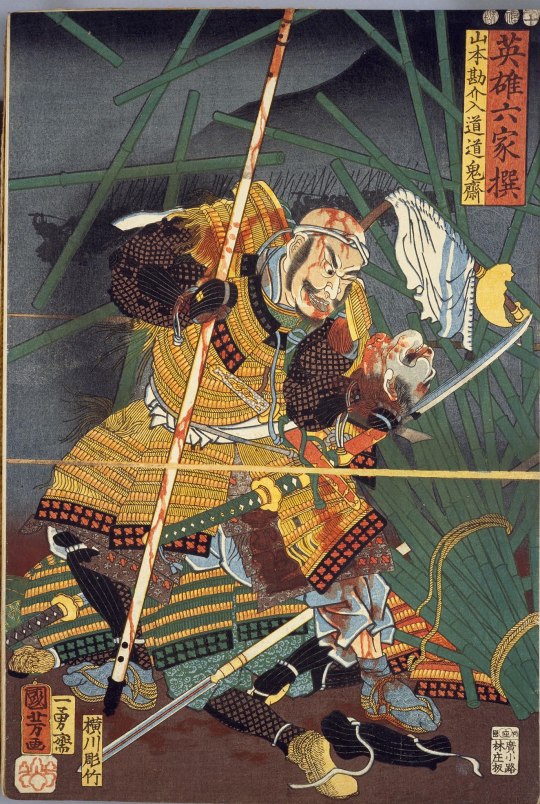
Yamamoto Kansuke Nyudo Doki, by Utagawa Kuniyoshi, 19th century
#utagawa school#utagawa kuniyoshi#art#japan art#ukiyoe#painting#fav#samurai#takeda clan#general#war#sengoku period
32 notes
·
View notes
Text
Nobunaga and the "Dairokuten Maō faith"
This was described in a tourism website, so it might not be necessarily true. That being said, the article claimed that the reason why Nobunaga called himself the "Dairokuten Maō" was because he might be someone who is a participant of the Dairokuten Maō worship/faith.
To explain this a little: I once mentioned that the Dairokuten Maō is actually worshipped in some areas. There are various possible reasons, but one possible reason is that in non-Buddhist faiths, this "demon king" is viewed as a guardian.
As a demon, the Maō tempts people away from Buddhist enlightenment by worldly possessions. Gold and riches and lustful pleasure. Therefore, if someone doesn't believe in Buddhism, it would make sense for them to think that this is actually a good thing and perceive the Maō as some kind of god of prosperity instead.
Slightly related to the above, there were also some medieval texts linking the Dairokuten Maō to Amaterasu and/or other deities. I'm not sure if this is in any way relevant to the worship of the Maō, but it might be relevant to Nobunaga's actions.
This is a narrative that supposedly came from the Taiheiki (possibly a more modernised translation):
「イザナギ・イザナミの第一の御子神が、「この国の主と成て」伊勢に鎮座したとき、第六天魔王が現れた。魔王は、この日本の国に仏法が広まると力を失うという理由から、天照大神の働きを妨害しようとした。
そこで天照大神は、魔王に「私は仏・法・��の三宝には近づかない」と誓った。魔王は怒りを鎮め、その血で契約書を書き、天照大神に手渡した。「世界が滅び去るまで天照大神の末裔をこの国の主とする。もし、天皇の命に従わず、国を乱し、人民を苦しめるものがあれば、魔王の眷属が必ず罰を与え、死をもって報いさせよう」
[太平記]
When Izanagi and Izanami's first deity offspring "became the ruler of this land" and settled down in Ise, the Dairokuten Maō appeared. Since he would lose his power if Buddhism spread throughout the land of Japan, the Maō attempted to interfere with Amaterasu Ōmikami's actions.
Therefore Amaterasu Ōmikami swore to the Maō, "I will not come near the Three Treasures of Buddhism; the Buddha, Dharma, and the monks". The Maō's anger was appeased, and he wrote a contract in his blood which he gave to Amaterasu Ōmikami. "Until the world perishes, the descendants of Amaterasu Ōmikami shall be the rulers of this land. Supposing that anyone disobeys the Emperor's order, disturbs the country, or causes suffering to the people, the Maō's kin and house will surely punish them and repay it with death."
Some articles I've seen claim that there are also similar narratives where the ones who made the deal with the Maō were Izanagi and Izanami instead. As they were the creator-gods, this version escalates the Maō's importance even further. Though, I haven't seen any quotes of the actual text of this version yet.
The Taiheiki is a classic that I would expect the samurai lords of Nobunaga's time are familiar with. The idea that Nobunaga called himself the Dairokuten Maō based on the above Taiheiki text would lend some credence to the theories saying that Nobunaga might have been aiming to abolish the shogunate to restore power to the emperor.
As seen above, the Maō proclaims to be the emperor's protector, and also someone who safeguards peace in the nation. Even if Nobunaga doesn't particularly worship the Maō, he might have been inspired to view himself as that "Maō's kin and house" who puts to death those who disturbs the nation in service to the emperor.
Edit: It slipped my mind a little when I was originally writing this, but the argument against this would be that at the time of the Enryakuji burning, the head abbot of the temple was actually the emperor's brother. Nobunaga's attack on Enryakuji can be perceived as slight against the imperial household.
On the other hand, you could also argue that the Maō's protection only extends to the sitting emperor. Therefore, if Nobunaga was acting based on the Maō's promise written in Taiheiki, attacking Enryakuji is not against that principle.
#oda nobunaga#dairokuten maou#dairokuten maoh#demon king of sixth heaven#demon king of the sixth heaven#japanese history#sengoku#sengoku period#sengoku era#samurai#warring states#warring states era#warring states period#theory#feudal japan
13 notes
·
View notes
Text

I’ll be heading down on the first day (9 Nov) with a timed ticket (pending details on which group A/B/C).
➡️ My rates are x0.0048, with minimum proxy fee of SGD$2/item. All purchase bonuses will be given accordingly.
➡️ Each AGF limited freebie is SGD$7. First come first serve for these.
➡️ Not taking orders for Otomate.
🌟 Eg 1. Item is 500 yen. Proxy fee is 500 x 0.0048 = SGD$2.40.
🌟 Eg2. Item is 300 yen. Proxy fee is 300 x 0.0048 = SGD$1.44 (rounded up to SGD$2)
You can drop me a DM if you have any requests. Will also be posting a lot of AGF booth POs in October. For first hand news, please follow my ig @ lydskisses ^^
#animate girls festival#AGF#agf 2024#Cybird#Ikemen vampire#ikemen villains#Ikemen prince#Ikemen sengoku#ikepri#ikevamp#ikevil#otome#otome merch#アニメイト#animate#Japan preorder#Japan Po
9 notes
·
View notes